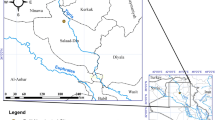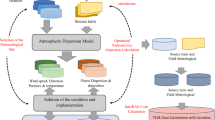Abstract.
A probabilistic analysis of atmospheric transport and deposition patterns from two nuclear risk sites—Kamchatka and Vladivostok—situated in the Russian Far East to countries and geographical regions of interest (Japan, China, North and South Koreas, territories of the Russian Far East, State of Alaska, and Aleutian Chain Islands, US) was performed. The main questions addressed were the following: Which geographical territories are at the highest risk from hypothetical releases at these sites? What are the probabilities for radionuclide atmospheric transport and deposition on different neighboring countries in case of accidents at the sites? For analysis, several research tools developed within the Arctic Risk Project were applied: 1. isentropic trajectory model to calculate a multiyear dataset of 5-day forward trajectories that originated over the site locations at various altitudes; 2. DERMA long-range transport model to simulate 5-day atmospheric transport, dispersion, and deposition of 137Cs for 1-day release (at the rate of 1010 Bq/s); and 3 a set of statistical methods (including exploratory, cluster, and probability fields analyses) for evaluation of trajectory and dispersion modeling results. The possible impact (on annual, seasonal, and monthly basis) of selected risk sites on neighboring geographical regions is evaluated using a set of various indicators. For trajectory modeling, the indicators examined are: 1. atmospheric transport pathways, 2. airflow probability fields, 3. fast transport probability fields, 4. maximum possible impact zone, 5. maximum reaching distance, and 6. typical transport time fields. For dispersion modeling, the indicators examined are: 1. time integrated air concentration, 2. dry deposition, and 3. wet deposition. It was found for both sites that within the boundary layer the westerly flows are dominant throughout the year (more than 60% of the time), increasing with altitude of free troposphere up to 85% of the time. For the Kamchatka site, the US regions are at the highest risk with the average times of atmospheric transport ranging from 3 to 5.1 days and depositions of 10−1 Bq/m2 and lower. For the Vladivostok site, the northern China and Japan regions are at the highest risk with the average times of atmospheric transport of 0.5 and 1.6 days, respectively, and depositions ranging from 100 to 10+ 2 Bq/m2. The areas of maximum potentially impacted zones are 30 × 104 km2 and 25 × 104 km2 for the Kamchatka and Vladivostok sites, respectively.
Similar content being viewed by others
References
AR-NARP: 2001–2003, On-going Project Atmospheric Transport Pathways, Vulnerability and Possible Accidental Consequences from the Nuclear Risk Sites in the European Arctic Arctic Risk of the NARP: Nordic Arctic Research Programme. http://glwww.dmi.dk/f+u/luft/eng/arctic-risk/main.html .
Baklanov, A., Bergman, R., Segerstahl, B. and Thaning, L.: 1996, ‘ Assessment of risk of airborne radioactive contamination from nuclear units in north-west Russia ’, IIASA Research Report, XP-96-043.
Baklanov, A. and Sørensen, J.H.: 2001, ‘Parameterization of radionuclide deposition in atmospheric dispersion models’, Phys. Chem. Earth B 26, 787–799.
Baklanov, A. and Mahura, A.: 2004, ‘Assessment of possible airborne impact from risk sites: Methodology for probabilistic atmospheric studies’, Atmospheric Chemistry and Physics 4, 485–495.
Baklanov, A., Mahura, A., Jaffe, D., Thaning, L., Bergman, R. and Andres, R.: 2002a, ‘Atmospheric transport patterns and possible consequences for the European North after a nuclear accident’, J. Environ. Radioact. 60 1–2, 1–26.
Baklanov, A., Mahura, A., Sørensen, J. H., Rigina O. and Bergman, R.: 2002b, ‘ Methodology for risk analysis based on atmospheric dispersion modelling from nuclear risk sites in northern Europe ’, DMI Scientific Report, 02-16, ISBN:87-7478-470-6, 54 p.
Bellona-www: 2003, Bellona Foundation, http://www.bellona.no/.
Bergman, R., Baklanov, A. and Segerstahl, B.: 1996, ‘ Integrated regional risk assessment: The case of radioactive contamination on the Kola Peninsula ’, IIASA Research Report, XP-96-044.
Bradley, D.J.: 1997, ‘Behind the Nuclear Curtain: Radioactive Waste Management in the Former Soviet Union’, in D. R. Payson ed, Battelle Press, Columbus, OH, 716 p.
Brown, K., Compton, K., Parker, F., Mahura, A., Baklanov, A. and Sørensen, J.H.: 2003, ‘Analysis of the dose commitments resulted from atmospheric transport and deposition from nuclear risk sites in the Russian far east’, IIASA Interim Report, IR-03-03, 194 p.
Danilyan, V., Vysotskii, V. and Maksimov, A.: 2000a, ‘Radioecological conditions on the territory of coastal service bases in he far-eastern region’, At. Energy 89 2, 673–679.
Danilyan, V., Vysotskii, V., Maksimov, A and Sivintsev, Yu.: 2000b, ‘Effect of the utilization of nuclear-powered submarines on the radioecological conditions in the far-east region’, At. Energy 89 6, 982–1003.
Egorov, N., Novikov, V., Parker, F. and Popov, V. (eds): 2000, The Radiation Legacy of the Soviet Nuclear Complex, Earthscan Publications Ltd., 236 p.
Ishikawa, H.: 1994, ‘Development of regionally extended/worldwide version of system for prediction of environmental emergency dose information: WSPEEDI, III -revised numerical models, integrated software environment and verification’, J. Nucl. Sci. Technol. 31 9, 969–978.
Mahura, A., Jaffe, D., Andres, R. and Merrill, J.: 1999, ‘Atmospheric transport pathways from the Bilibino nuclear power plant to Alaska’, Atmos. Environ. 33/30, 5115–5122.
Mahura, A.: 2001, Probabilistic Assessment of Atmospheric Transport from Nuclear Risk Sites, Ph.D. Thesis, Russian State Hydrometeorological University/Kola Science Center, 172 p.
Mahura, A.: 2002, ‘ Assessment of impact of Russian nuclear fleet operations on Russian far eastern coastal regions ’, IIASA Interim Report, IR-02-004, 76 p.
Mahura, A. and Baklanov, A.: 2002, ‘ Probabilistic analysis of atmospheric transport patterns from nuclear risk sites in Euro-Arctic region ’, DMI Scientific Report, 02-15, ISBN: 87-7478-469-2, 87 p.
Mahura, A., Baklanov, A., Sørensen, J.H., Parker, F.L., Novikov, V., Brown, K. and Compton, K.: 2002, ‘ Probabilistic analysis of atmospheric transport and deposition patterns from nuclear risk sites in Russian far east ’, DMI/IIASA Scientific Report, 02-17, ISBN: 87-7478-471-4, 80 p.
Merrill, J., Bleck, R. and Boudra, D.B.: 1985, ‘Techniques of Lagrangian trajectory analysis in isentropic coordinates’, Monthly Weather Rev. 114, 571–581.
Nilsen, T., Kudrik, I. and Nikitin A.: 1996, ‘ The Russian northern fleet. Source of radioactive contamination ’, Bellona Research Report, Vol. 2, 168 p.
NWA: 1995, Nuclear Wastes in the Arctic, ‘ An analysis of arctic and other regional impacts from Soviet nuclear contamination ’, Research Report, OTA-ENV-632.
Romanova, V. and Takano, M.: 2002, ‘ Atmospheric transport of radioactive nuclides from Russia to neighboring countries ’, IIASA Interim Report, IR-02-010, 26 p.
Sørensen, J.H.: 1998, ‘Sensitivity of the DERMA long-range gaussian dispersion model to meteorological input and diffusion parameters’, Atmos. Environ. 32, 4195–4206.
Sørensen, J.H., Rasmussen, A., Ellermann, T. and Lyck, E.: 1998, ‘Mesoscale influence on long-range transport; evidence from ETEX modelling and observations’, Atmos. Environ. 32, 4207–4217.
Yablokov, A., Karasev, V., Rumyantsev, V., Kokeyev, M., Petrov, O., Lystsov, V., Yemelyanenkov, A. and Rubtsov, P.: 1993, Facts and Problems Related to Radioactive Waste Disposal in Seas Adjacent to the Territory of the Russian Federation White Book . Office of the President of the Russian Federation, Moscow.
Author information
Authors and Affiliations
Corresponding author
Rights and permissions
About this article
Cite this article
MAHURA, A.G., BAKLANOV, A.A., SØRENSEN, J.H. et al. ASSESSMENT OF POTENTIAL ATMOSPHERIC TRANSPORT AND DEPOSITION PATTERNS DUE TO RUSSIAN PACIFIC FLEET OPERATIONS. Environ Monit Assess 101, 261–287 (2005). https://doi.org/10.1007/s10661-005-0295-7
Received:
Accepted:
Issue Date:
DOI: https://doi.org/10.1007/s10661-005-0295-7




